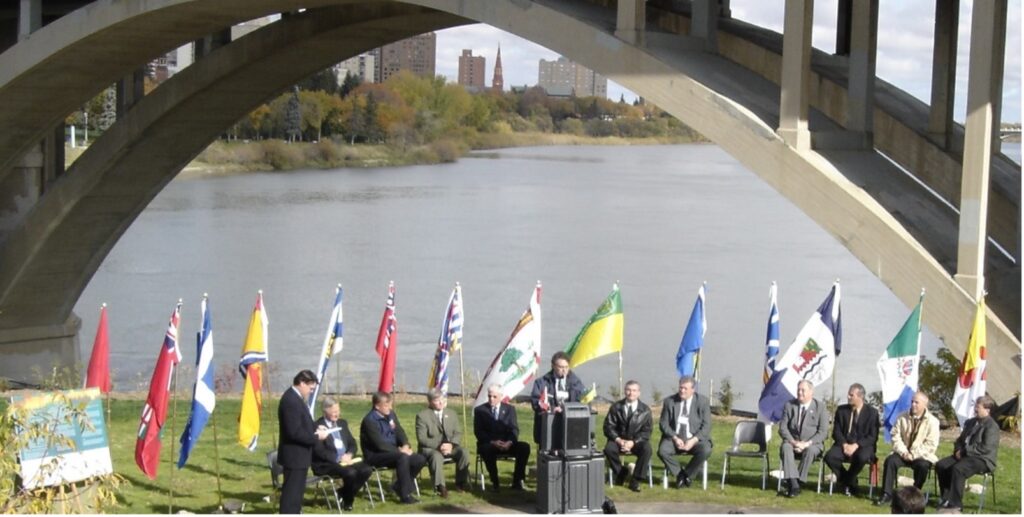
Opinion: Facing the reality of wildfire in Canada
August 29, 2023
By Kelvin Hirsch
Kelvin Hirsch, retired director of forest research with the Canadian Forest Service, says managing the risks from wildland fire is a shared responsibility of individuals, neighbourhoods, communities, businesses, and all levels of government.
 The Canadian Council of Forest Ministers unveils the Canadian Wildland Fire Strategy in 2005. Photo: Kelvin Hirsch.
The Canadian Council of Forest Ministers unveils the Canadian Wildland Fire Strategy in 2005. Photo: Kelvin Hirsch. In 2003, severe wildfires, particularly the Okanagan Mountain Park fire at the south end of Kelowna, B.C., served as a wake-up call for wildland fire management agencies in Canada. At the time, it was the most damaging wildfire incident in the era of modern fire management in this country. It caused the evacuation of 27,000 people, burned 239 properties, cost tens of millions of dollars in direct suppression costs and $210 million in insurance payouts. Ultimately, it became a major catalyst for re-thinking Canadian wildland fire management policies and practices.
Recognizing that this type of event could become more frequent or even commonplace, wildland fire management leaders from the federal, provincial, and territorial governments – working collaboratively under the auspices of the Canadian Council of Forest Ministers (CCFM) and in conjunction with the Canadian Interagency Forest Fire Centre – shared information, conducted analyses, and collectively developed Canadian Wildland Fire Strategy.
The strategy was aspirational in nature, providing an innovative and integrated vision for wildland fire management, shifting the philosophy from an almost exclusive focus on fire suppression to a more holistic, risk management approach that also included proactive mitigation, effective preparedness, and efficient recovery. The envisioned desired future state included communities that are empowered to enhance their own safety and resilience, forest ecosystems that are healthy and productive, and wildland fire management agencies that utilize modern business practices.
At the annual CCFM meeting in the fall of 2005, ministers from all jurisdictions officially signed a declaration supporting the strategy and committed to seek an estimated $2.3 billion over 10 years to jointly address the most critical needs. Over the next decade, wildland fire management agencies independently and opportunistically took actions consistent with the principles of the strategy, but for a variety of reasons, including the economic downturn of the late 2000s and other fiscal and political priorities, progress was slow and the initial inter-governmental implementation plan was never fully realized. After the wildfire in Fort McMurray in 2016, a CCFM report concluded that the strategy’s goals and objectives were still relevant and issued a renewed call to action.
Since then, improvements have been made through the dedicated efforts and perseverance of many, but unfortunately, they have not kept pace with the accelerating and intensifying breadth and complexity of managing wildland fire. In short, the current system is simply being overwhelmed by a myriad of factors including, but not limited to: the changing climate and more extreme weather; degradation of forest health due to insects, disease, and drought; increased accumulation and/or continuity of fuels; growing residential, commercial, and industrial development in or near wildlands; difficulty in recruiting and training new staff; and replacing and/or enhancing aging equipment and aircraft.
With this year’s record fire season, we are seeing more wildfires raging, communities threatened, citizens evacuated, homes lost, livelihoods quashed, smothering smoke, greenhouse gases released, ecosystems impacted, first responders suffering, firefighters perishing, and lives changed. Once the flames are extinguished and the smoke has cleared, there will be reflection, reviews, and recommendations about what worked well and what could be done differently. Many ideas are already being put forward in both traditional and social medias and many other options will undoubtedly be identified and considered by politicians and senior officials; but there is no single, silver bullet.
An additional looming and valid question is: what amount of new funding are governments able to invest to reduce the risk from wildfire when there are so many other challenges facing society today? New resources would, undoubtedly, be beneficial in some communities in some locations; but, overall, will this additional money substantially reduce the negative impacts of wildfires in Canada as a whole? To quote a 1993 paper by Brian Stocks and Al Simard, “total fire exclusion [is] neither economically feasible nor ecologically desirable,” and therefore, “wildfires will always be a major force in Canadian forests and society must adapt to this fact.” This means that regardless of where we live, we as citizens of this largely forested and flammable nation must accept that a small percentage of wildfires will continue to escape even the most aggressive initial suppression efforts and become large, severe forces of nature. Similar to tornadoes and hurricanes, we cannot control them and they are here to stay.
Ultimately, we have to learn to live with wildfire, meaning each of us must do our part to take all feasible risk reduction measures, but also, paradoxically, accept that these actions may not always be enough because the risk will never be zero. The path forward will emerge from a significant mind shift away from the belief of human mastery over nature.
And, while change may not be easy, we are fortunate to already have some excellent examples to emulate such as:
- homeowners creating ignition resilient properties;
- communities, such as Logan Lake, B.C., and Bear River First Nation, N.S., both of which have implemented comprehensive FireSmart programs;
- the “We are Fire” initiative in the Saskatchewan River Delta that integrates Indigenous-led fire practices and western fire management;
- the pragmatic use of prescribed fire, fuels management, and fire suppression in Banff National Park to address both public safety and ecological integrity;
- and the list goes on.
An underlying tenet of the 2005 strategy was that managing the risks from wildland fire goes well beyond the wildland fire management agencies and is a shared responsibility – of individuals, neighbourhoods, communities (both Indigenous and non-Indigenous), businesses (including insurers), and all levels of government – that requires integrated and co-operative actions. This was true 20 years ago and appears even more essential now and in the future.
 Kelvin Hirsch worked for 33 years as a wildland fire researcher, science-policy advisor, and research director with Natural Resources Canada, Canadian Forest Service. Find him on LinkedIn here.
Kelvin Hirsch worked for 33 years as a wildland fire researcher, science-policy advisor, and research director with Natural Resources Canada, Canadian Forest Service. Find him on LinkedIn here.
Print this page